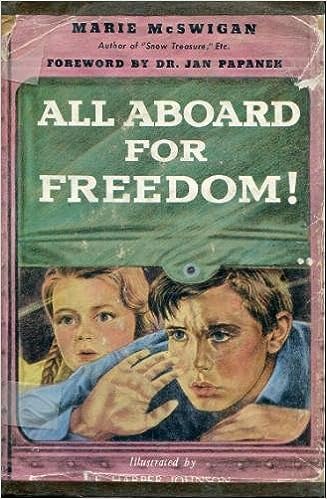The author of this book, Marie McSwigan, also wrote the popular World War 2 story, Snow Treasure, which is based on a true story of children outwitting the Nazis to rescue the country’s gold reserves. All Aboard for Freedom! is also based on a true story of a group of children outwitting oppressive authorities, this time in Czechoslovakia in 1951. And the oppressors are not Nazis but rather their own countrymen who have bought into the Communist regime aided by the Russians.
Ludmila Novak is foster mother to five children, orphaned by the war. The oldest, age thirteen, is Franta Kristufek. When the Communist authorities threaten to separate the children and their beloved foster mother from each other and send the children to state run institutions, Fran comes up with a plan to keep them all together. However, the plan involves a train, the help of adults, and a very dangerous, time-critical strategy for escape. Who can Fran trust to help him escape Czechoslovakia to freedom in Germany? How can he keep his plan a secret with four other children involved, the youngest only four years old? What if “they” (the Communists) come for the children before they can put their plan into action?
This book, published in 1954, is very 1950’s, very anti-communist and pro-American, and very exciting. The children, especially Fran, are believable but also intrepid and imaginative. The story reminds me of one of Helen MacInnes’ Cold War spy novels, but it’s written for children, not adults. And it pictures characters, a time, and a situation that we in the West are in danger of forgetting—the people of Czechoslovakia who suffered under communist rule and yearned for the freedom we now take for granted. One more plus to this book: Fran stops to pray for God’s guidance and protection several times during the story. And that resort to prayer seems quite believable and wise, too.
All Aboard for Freedom is a book for train lovers, patriots, and adventurers. Pair it with Snow Treasure for a double dose of good reading.









